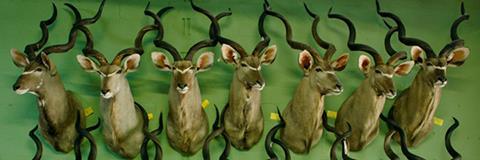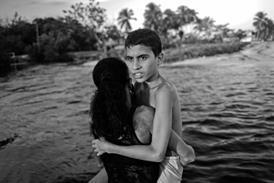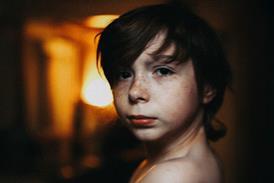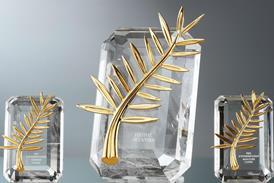Dir. Ulrich Seidl. Austria/Denmark, 2016, 91 mins

Intentionally, of course, Ulrich Seidl’s Safari is a very difficult watch. All the Austrian auteur’s trademarks are there – the formal, deliberate compositions, the distanced tone, the off-beat dance with an ugly partner. The taboo subject of big game hunting lends the expectation of an explicitly verbalised homily as the viewer is confronted with painfully upsetting images of dead animals being skinned and butchered. Yet these images do the only real talking in Seidl’s masterful art documentary; the walls of stuffed heads of felled majestic game, the carcasses of dying beasts which crumple in on themselves. His Austrian hunters talk passionately about their “sport”, but words ultimately mean little here.
The result is as agreeably complex as it is horribly provocative.
Outside what seems like an assured festival run – Safari moves onto Toronto after its Venice world premiere – Seidl’s documentary will struggle to reach a wide audience due to the graphic nature of its images and detached aspect. Those it reaches, however, should be profoundly affected by what they have seen. Less ironically distanced than the Austrian auteur’s Paradise trilogy or 2014’s In The Basement, Safari is a difficult film to leave behind. Some of its images are defining.
Safari opens with a static shot of a hunter sounding a bugle in an anonymous – presumably European – forest before moving to Namibia, where the potbellied Manfred and Inge Ellinger slather themselves in suntan lotion before discussing the prices of animal pelts.
Familiar to viewers of In The Basement, the Ellingers have returned to bag more trophies, although Manfred’s creaky, overweight, beer-guzzling ways don’t lead to much action from his hide. The main focus, though, is on the distinctly middle-class hunting family led by Gerard, Eva and their teenage children Manela and Tina who are on a big-game safari in the Leopard Lodge.
Seidl’s shots are precision-engineered for distanced formality; he returns time and time again to majestic animal heads mounted on the wall, with his subjects placed amongst silently amongst them. Local African workers are tellingly given no voice as Gerard and Eva shoot (or “bag”) “pieces” from what seems like very close distance and give each other “hunter’s hails” with their nerves palpably barely under control despite the loaded advantage they maintain over their prey, crying tears of joy at their success.
A gnu, a zebra – when a tower of giraffes moves elegantly into view in the distance, the viewer is aghast. Seidl then hammers home an excruciating abbatoir scene where the local butchers – hunters nowhere to be seen at this point – skin, disembowel, ex-sanguinate and dismember the corpse. Enough said, really. But it’s all difficult: from the game dog Ruby licking the wounds of a dying beast to a zebra crumpling in on itself like a broken doll to the final desperate lunges of the twisted neck of a felled giraffe, these images don’t lend themselves to Seidl’s unsual detachment.
Working again so effectively with the Paradise trilogy’s director of photography Wolfgang Thaler and editor Christof Schertenleib, Seidl’s camera gives much food for thought. It seems as if much less of Safari is staged – or recreated - than, say, In The Basement, and the characters are allowed spontaneity within his tight frames. The result is as agreeably complex as it is horribly provocative.
Production company: Ulrich Seidl Film Produktion.
International sales: The Coproduction Office
Producer: Ulrich Seidl
Executive producers: Eva Mulvad, Pernille Rose Gonkjaer, Mikaela Krogh, Sigrid Jonsson Dyekjaer
Cinematography: Wolfgang Thaler
Editor: Christof Schertenleib
Featuring: Gerald Eichinger, Eva Hofmann, Manuel Eichinger, Tina Hofmann, Manfred and Inge Ellinger, Marita and Volker Neemann, Markolf Schmidt, Eric Müller.
























